Witnessing your beloved pet fish swimming upside down can be perplexing, sparking a flurry of questions about its health and well-being. If your aquatic companion exhibits this unusual swimming pattern, it clearly indicates underlying issues. Understanding the root causes behind this condition and implementing timely treatment measures are crucial for restoring your fish’s vitality.

One day you wake up to the stunning sight of your favorite goldfish acting like a balloon.
A fish floating at the top of the tank but not dead yet (even actively moving around) can be confusing to witness. What does that signal?
What about the other way around — your fish is swimming upside down but hangs out on the bottom?
This can happen to almost any fish species, not only goldfish.
Truth to be told if you find your little buddy swimming turned belly up, then its condition has probably been around for a while now.
The initial stage can be detected when you notice sideways or even nose-down-tail-up swimming. Any form of fish imbalance is considered a potential threat to its health.
Why is your fish hovering upside-down, but still seems alive and active?
If a fish displays such behavior it means that it has buoyancy issues. If that happens then you’d need to react on time and start treatment immediately.
Here’s the reason behind a fish that floats upside-down, yet remains alive:
The impaired buoyancy in fish is caused by a malfunction of their swim bladder. When affected by Swim Bladder Disorder fish will often lose the ability to swim properly. They will float uncontrollably to the top of the aquarium, turned upside down, while still being alive.
In some cases, the fish will lie upside down or sideways on the bottom and be unable to swim upwards. Affected fish will face difficulties maintaining their floating balance, as the swim bladder is located in the lower half of the body.
The swim bladder disease in fish is not lethal on its own and it is instead a symptom rather than an independent condition.
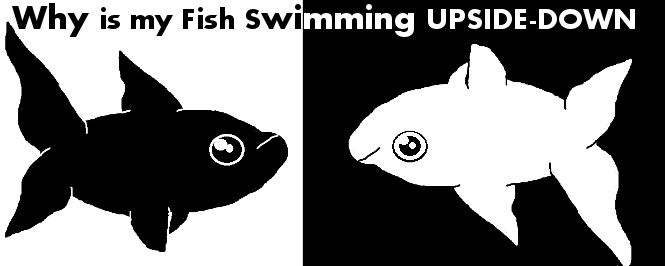
Note that in some fish such as the upside-down catfish swimming with the belly up is a typical trait of character.
What causes swim bladder disease?
A swim bladder malfunction is caused by a temporary or permanent deformation of the swim bladder. When it is deformed or narrowed in some way, the fish loses the ability to balance its body, while swimming.
The reasons behind that can be the pressure from a swollen belly, too much air swallowed, injury, or bacterial infection.
In addition to these reasons, fatty deposits in the liver, kidney cysts and egg binding can also affect the bladder and lead to buoyancy issues.
In some fish, low water temperatures can enlarge the gastrointestinal tract by slowing down digestion. For the aforementioned reasons, this also puts the swim bladder under pressure.
Sometimes after eating too much a fish may gulp some air on purpose, to regulate its buoyancy.
To cure your fish you need to investigate the reason for its bizarre behavior.
You should treat it accordingly after you estimate the nature of the problem, ideally through your local veterinarian.
How to treat the different conditions that cause your fish to swim upside down?

Relocate your pet fish to a hospital tank immediately after noticing the odd behavior.
This way you’ll have more control over the treatment without affecting other fish. All food or medication will go where it belongs – in your ill fish.
Sometimes the treatment requires days. Be sure to check the water parameters and maintain healthy water quality in the recovery tank.
That being said, here are the reasons behind swim bladder disorder and how to treat them:
#1. Treating constipation that results in a swim bladder malfunction
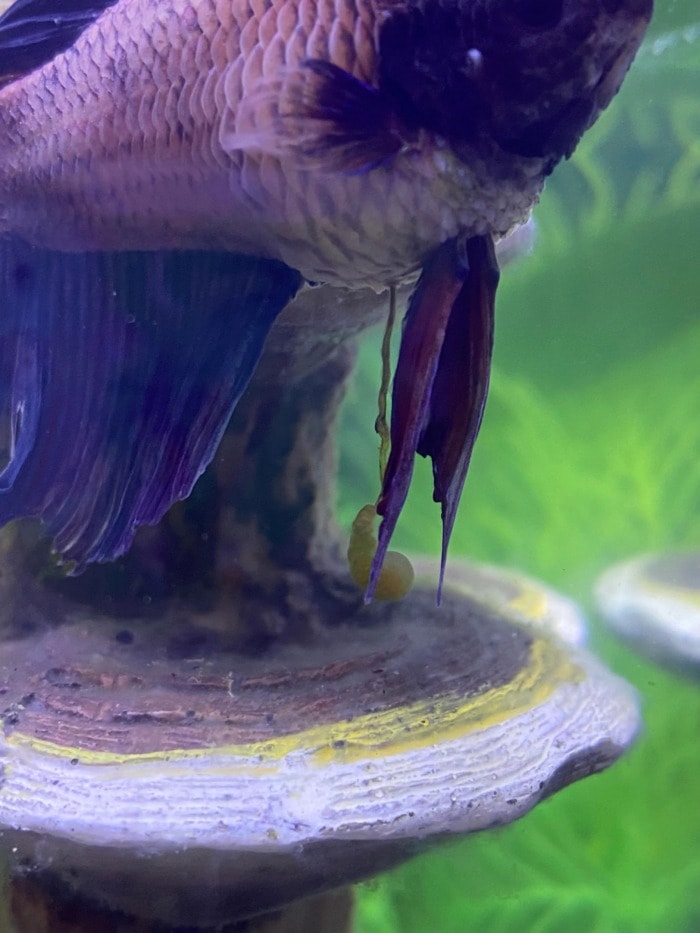
This is a manifestation of a swim bladder disorder that’s relatively rare. Fortunately, it is the easiest to treat. Constipation will cause a bloated stomach, which will press against the swim bladder.
A good approach would be offering your pet fish a specific food source that’s fiber-rich.
The fiber will force everything out of your fish’s digestive system.
Here’s how to treat swim bladder disease caused by constipation in your omnivorous or herbivorous fish such as goldfish and the like:
- Thaw a frozen pea. It is better to leave the pea to thaw naturally. However, as this disease’s treatment can be time-sensitive , I recommend microwaving it to the defrost function.
- Boil the pea. Cook the pea in boiling water while being careful not to overcook it.
- Peel the skin off of the pea. The pea skin may cause swallowing complications for fish. You need the meaty insides of the pea for the treatment.
- Soak the pea in water. This is done to avoid swelling of the pea inside of the fish’s stomach. Mind that the cooked pea will sink, so use a shallow container for the soaking.
- Feed your fish the cooked pea. Hand-feed the pea if needed. The fish will have difficulties getting the food. This is where the hospital tank comes in handy.
- Skip feeding in the next 24 hours. Let the fibers in the pea do their job at helping your fish with digestion.
- Clean off any leftover food after the offering. Hospital tanks are usually smaller. The water will quickly become dirty. A sudden ammonia spike, caused by rotting food is the last thing you’d want in a small tank.
This is the best-case scenario for constipation treatment.
The belly of the fish will lose volume, allowing for the swim bladder to function correctly.
Another good source of fiber for treating constipation, especially for a carnivorous fish such as a Betta, is Daphnia.
At times Daphnia can be somewhat difficult to find in your local fish store, but you can find it in better online stores for aquarium supplies such as Amazon (or just click this link).
Anyhow, sometimes the fish may also experience a loss of appetite.
In this case, you have no other option than to starve it. Fast the pet for 3 days.
On day 3 you should feed the cooked pea. Again, fast your fish for another 24 hours after that.
To avoid future bloating issues, you should diversify the fish’s diet. But more on that below.
Constipation may also be caused by food that’s swelling inside your fish’s tummy.
Monitor the fish’s stools: if they do not properly leave the body and hang from its rear for a couple of seconds, then that’s a clear sign of a constipated fish.
#2. Bacterial swim bladder treatment

How to kill bacteria in the swim bladder of your fish:
Sometimes swim bladder disease is caused by a bacterial infection.
This will result in the bladder being filled with fluid.
Research shows that sometimes, swim bladder inflammation can occur with seasonality.
It can be estimated that the bladder holds liquid with an ultrasound diagnosis.
If liquid is present, the infection is either from spoiled water quality or bacteria.
The only sure way to confirm the cause is by a method called pneumonectomies.
Essentially, it involves sticking a needle directly into the bladder and testing the fluid for the type of bacteria causing it.
Knowing who the offender is, proper antibacterial treatment can be applied.
However, in their panic, most aquarists start treating the ill fish with numerous antibiotics.
If the issue doesn’t come from bacteria, but rather water quality, it’s strongly recommended that antibiotics be avoided.
The misuse of antibiotics will cause more harm than good to a fish’s immune system.
However, if you did measure the water parameters and are confident they’re not what’s causing the condition, using a broad-spectrum antibiotic is your best bet. Minocycline or Erythromycin are good examples.
Of course, your best course of action is to take the fish to the vet.
When an infection is present the fish will display other symptoms alongside swimming upside-down.
There may be a loss of appetite, stiff fins, and uncontrollable shaking.
Note that to keep your fish safe from harmful bacteria and other pathogens you should consider getting a UV sterilizer.
#3. Bloating from swallowing too much air
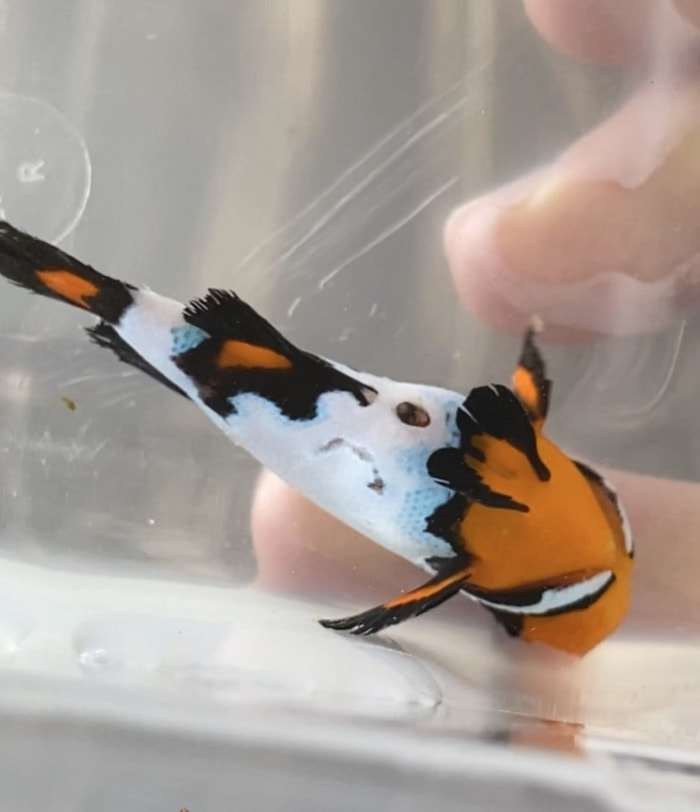
In a fish, there are actually two sacks acting as swim bladders. The larger one of them is directly connected to the stomach.
Whenever you feed non-sinking food you risk greedy fish gulping too much air while having their feeding frenzy. This may lead to a bloated swim bladder and therefore a disturbed buoyancy.
In this case, a boiled pea treatment will suffice.
#4. Birth deformation of the swim bladder
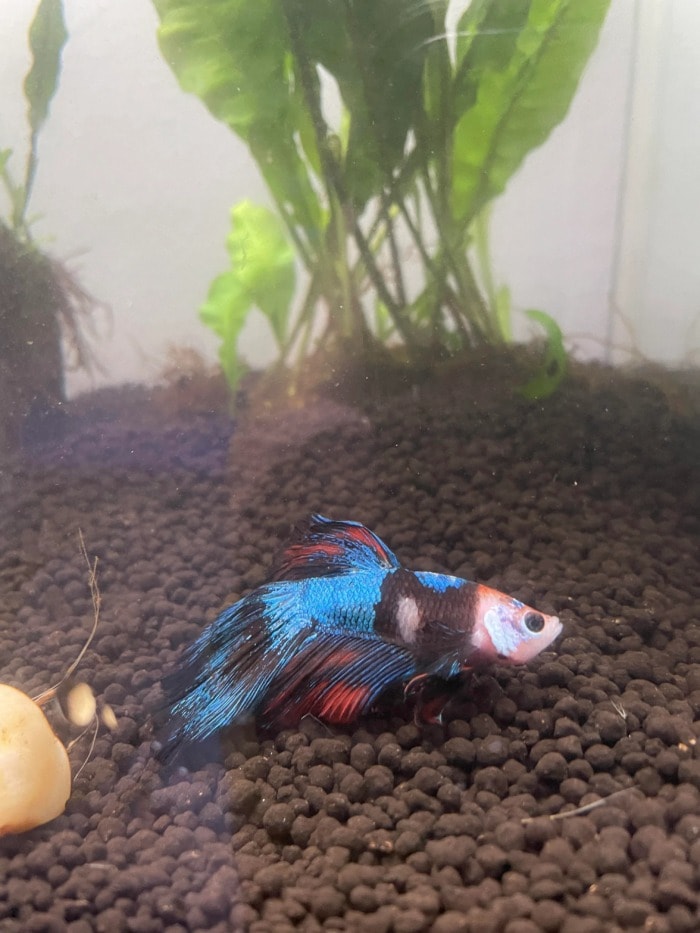
Sometimes, the reason for a malfunctioning swim bladder can be a birth deformity:
The swim bladder disorder is mostly seen in goldfish and bettas. Although a betta laying on its side could mean a number of things (click the link to see those explained), in goldfish it is not the case.
These two particular species have been continuously bred over time, to achieve aesthetic diversity.
The beautiful fish you see at fish stores result from genetic selection.
However, with selective breeding come physical deformations.
This is why it’s so common to see these two species suffering from swim bladder issues (with goldfish holding the lead).
If a birth deformation is causing issues in your fish’s swim bladder, little can be done.
You will need to apply special care, to ensure your fish leads a happy life.
But, in time the condition will worsen and eventually turn lethal.
Often if the SBD is the result of a birth defect, symptoms are present at an early age.
An easier diagnosis is somewhat a relief because no further investigation is needed.
Another untreatable condition that will suppress the swim bladder is the development of tumors.
Your fish may have cysts growing in its kidneys, which will enlarge.
#5. Physical damage or injury
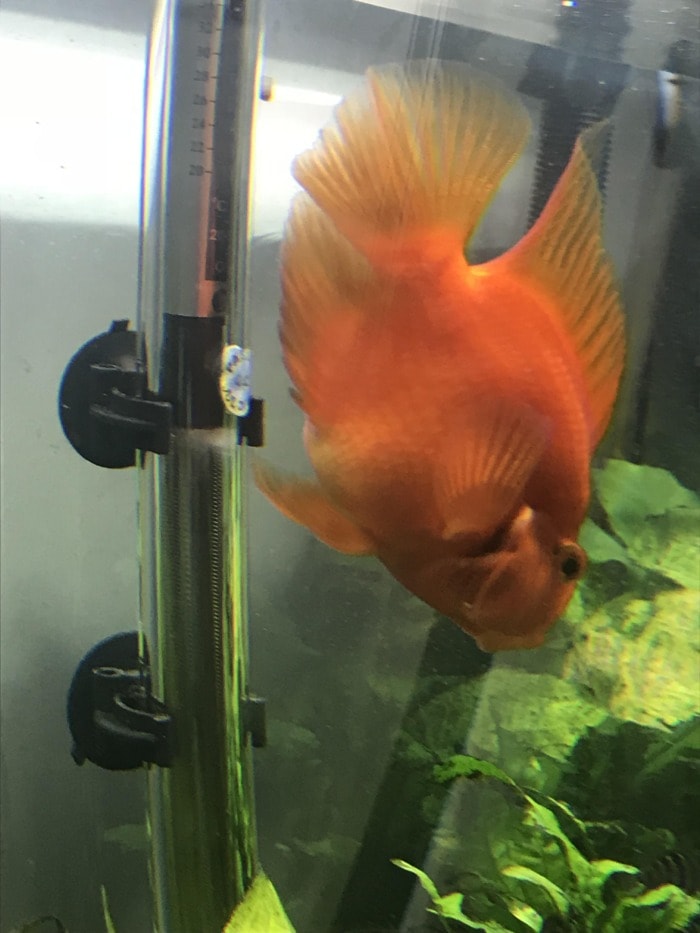
A high drop, engaging in a confrontation with other aggressive fish species or other mechanical damage can cause SBD:
If the swim bladder has been damaged by an injury, say, during transportation, there’s nothing you can do about it.
If your fish has just arrived and is being this way, without improvement from previous treatments, it is probably a goner.
It’s really sad, as these cases happen on occasion and there’s nothing that can be done.
I recommend considering a humane way to euthanize it.
You will spare it from suffering a slow and unpleasant death.
#6. Poor aquarium water quality (high nitrates)
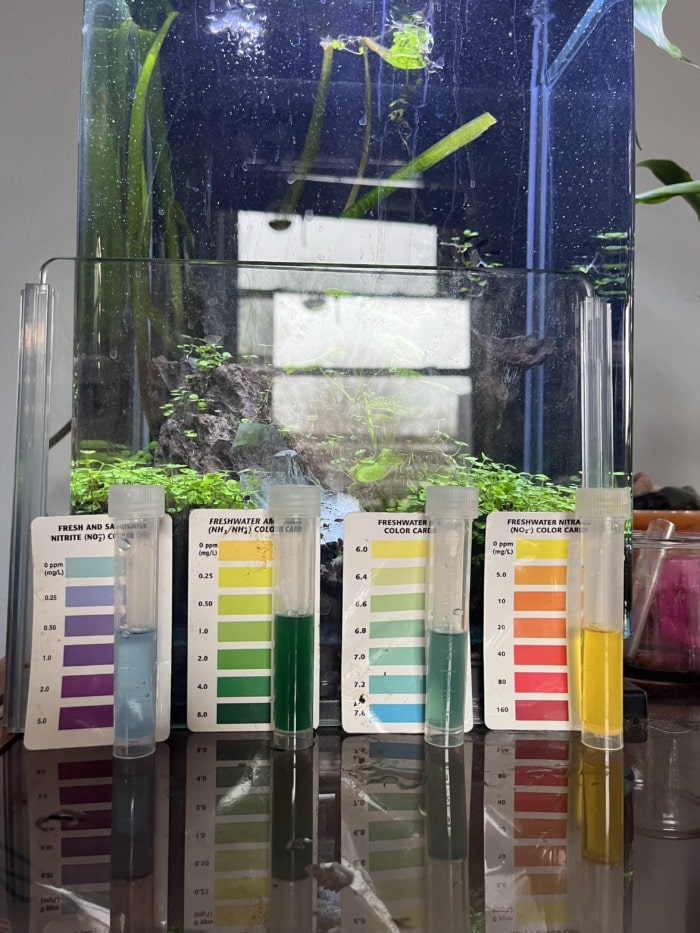
Neglected water conditions may very well be the reason for an infected bladder:
As mentioned the disease is often found in goldfish. Aside from selective breeding, there is another reason for that.
Goldfish are known to make a mess in an aquarium. They poop way more than other fish of their size. Therefore they would need more gallons of water per fish than with others.
Unfortunately, this is often overlooked by new fishkeepers.
Significant amounts of waste will result in ammonia spikes.
The ammonia then converts to nitrites (NO2), which become nitrates (NO3).
Research has shown that high levels of Nitrate in the aquarium can be related to swimming bladder infections.
Here’s a visual diagram from the research that shows the correlation between side swimming and high nitrate levels in the water:
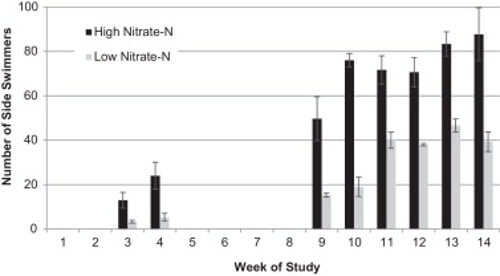
In fact, if a fish has swim bladder issues, it’s a strong sign that Nitrate poisoning is on the way.
Long-term exposure to nitrate levels of even 20 ppm (parts per million) can cause this.
Note that using a liquid water test kit is somewhat mandatory when accurately assessing the water’s parameters in your aquarium. Test strips can be quite off and only give a crude estimation of the actual Nitrate levels in the fish tank. Make sure to use a liquid test proven to take accurate measurements. I recommend using this or a similar one as it has done well for me so far.
Anyway, after constipation, nitrate intoxication is the second most common reason for sideways or upside-down swimming in fish.
To treat SBD in this scenario perform a change of up to 40% of the aquarium water over the course of a day, depending on the level of Nitrate. You’ll want to bring them down to about 15 ppm or less. To avoid causing further chemical shock to the fish only remove 5% to 10% of aquarium water per hour. Relocate the ill fish to a larger tank as soon as possible.
If you can’t provide more gallons of water, be consistent with the water changes or learn how to permanently keep the Nitrate at safe levels.
Nitrate-causing gunk can also build up in the aquarium’s filter, so change/rinse it as needed.
If your fish experiences upside-down swimming after a water change, this may be a sign of environmental stress.
Sometimes after a huge water change that’s done at once (40% to 50%), the fish will start to breathe heavily and swim upside-down.
Even if only one fish displays the symptoms, it’s a strong confirmation of stress.
Osmoregulation is the ability of a fish to maintain osmotic pressure in its body fluids. An imbalance in that pressure could cause swollen organs and a malfunctioning swim bladder in aquarium fish.
Though nitrate is toxic in the long run, fish adapt to its presence to a degree. In the case of a nitrate poisoning event, you should remove the nitrates gradually to avoid further worsening the swim bladder condition.
Usually, in smaller tanks, there are not enough plants to control the nitrate levels, which can lead to an infected swim bladder.
#7. Fast the fish for a few days
This could be a good course of action if you’ve confirmed through a vet that your fish is constipated or has something that does not pass in its stomach.
If the swim bladder disease is caused by an enlargement of the gastrointestinal tract, you’d want to start the treatment by putting your fish on a three-day fast.
The lack of food will prevent any further blockages of the intestines and stomach.
Meanwhile, you’d want to increase the temperature of the water to 78 – 80°F and leave it at this temperature until the end of the treatment.
This will relax the intestines and reduce the swelling.
Finally, if your fish is carnivorous, such as a Betta, you’d want to give it a few pieces of frozen, freeze-dried or live daphnia during the fast.
The daphnia will act as a laxative that will push out any food matter blocking the gastrointestinal tract.
Author’s note: A short fasting is the easiest course of action when your fish has constipation issues. However, from what I’ve seen, constipation is rarely the cause ofupside-down swimming in pet fish.
Efficient ways to prevent swim bladder disorder in the first place?
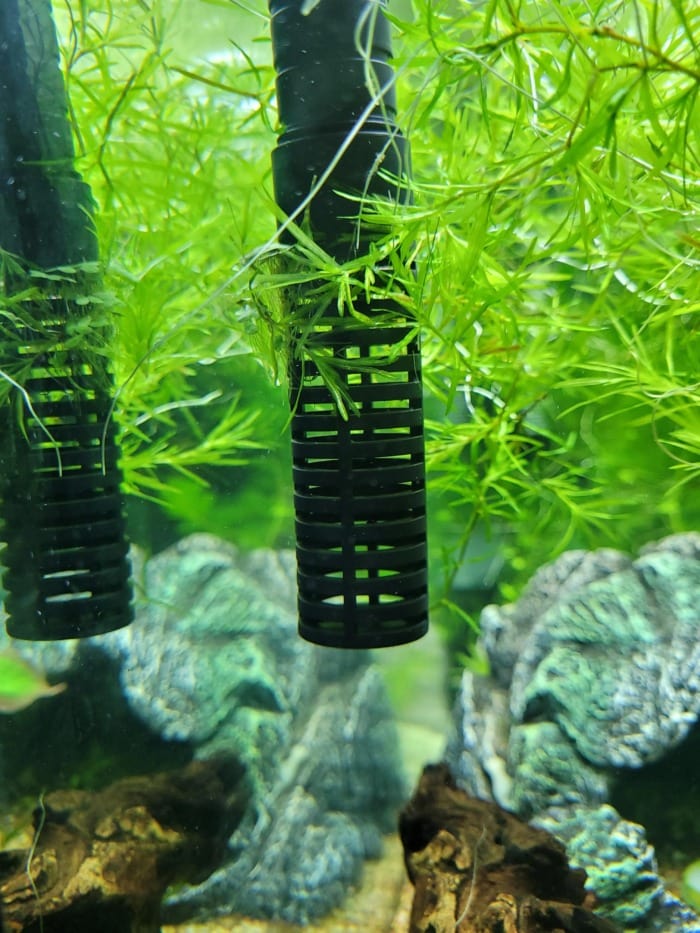
Do these to ensure your fish willnever have to face swim bladder disease again:
- Avoid overfeeding: Providing your aquatic pets with too much food actually doubles the trouble:
Fish do not recognize the concept of overeating. This makes you responsible for the amount of food they will consume each meal. More often than not , they will eat more than is needed when offered.
This may lead to a bloated belly, pressing against the swim bladder. One pinch a day should be enough for a small fish like a Betta.
Related: How to Treat a Bloated Betta?
To avoid worrying about dosing food and timing you can just get an automatic fish feeder.
One that really stands out is the Eheim automatic feeder unit. It works reliably and you will 100% not overfeed. Make sure you choose the right food, set it, and change the batteries every couple of months.
That’s it.
Oh, by the way, here’s a link to the feeder (at Amazon).Anyway, another outcome of overfeeding is water contamination.
Leftover food will quickly break down into ammonia, overwhelming the aquarium’s beneficial biofilter of bacteria. When this happens the fish tank will experience a nitrate spike that may lead to a swim bladder internal infection.
- Avoid feeding floating foods. Pellets or other food that floats at the water’s surface encourages gulping air.
Too much air in the belly of a fish can end up in its swim bladder. This will violate the balance and cause buoyancy issues.
Feed sinking food if possible.
- Avoid feeding air-filled foods. Some types of food will be more porous in texture than others. This introduces unwanted air in the fish’s stomach.
The air from the stomach may get into the swim bladder and enlarge it.
- Soak foods before offering. By soaking dried foods in water before offering you allow them to expand.
This will prevent eventual expansion inside of your fish’s belly.
- Thaw frozen foods. Whenever you offer a frozen meal, it should be fully thawed. These foods will gain volume when thawed.
If this happens inside of your fish, it will lead to bloating.
- Perform regular water changes. As much as this goes without saying, I am still obligated to mention it.
Water changes will keep the nitrates in the aquarium in check, preventing potential bladder infections.
- Buy a large filter. The bigger the filter – the more beneficial bacteria your fish tank will house.
The more bacteria, the stronger the biological filtration, lowering the chance of bladder infection.
Canister filters are the most spacious so far. Here’s a list of those.
- Maintain the water temperature. Fish are cold-blooded creatures.
This means that their metabolism is strongly dependent on their body’s temperature. Colder water will inevitably slow their ability to digest food efficiently and on time.
This can lead to constipation.
If you have a small tank check my guide on some of the smallest and yet reliable fish tank heaters.
- Diversify the diet of your fish. Once a week feed your fish high-fiber foods.
It could be a pea or any other fiber-rich source of food your fish will be willing to eat.
Another way to prevent SBD is by occasionally feeding your fish bloodworm.
- Avoid ball-like fish. The fancy goldfish is a good example. When stocking your tank avoid fish that are being bred to achieve a certain ball-like shape.
In general, that’s most of today’s goldfish varieties.
Be mentally prepared for a grim ending
It is fairly important to point this out.
With swim bladder disorder there won’t be a happy ending every time. Usually, if the problem is caused by constipation the treatment is easy and efficient.
However, this is not always the case.
There are numerous factors that can cause this condition. A proper, yet timely diagnosis is not always possible.
Be prepared for everything.
My Conclusion
Swim bladder disease is a tricky condition to treat and I’ve personally fought it numerous times. In my opinion, the key to success is reacting in time.
Why are you still reading? Hurry up and help your fish buddy before it’s too late.
There’s always hope, even though an upside-down fish usually signals the opposite.
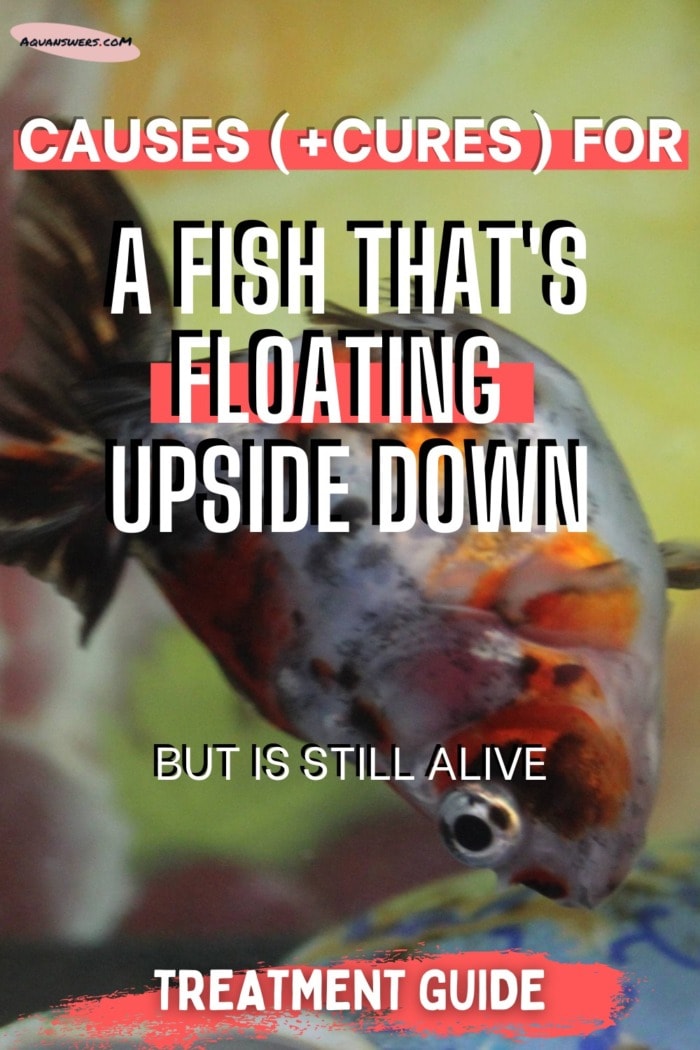
Leave me a comment below if you need more answers.






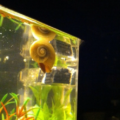




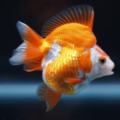
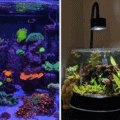
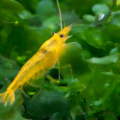
My goldfish is just laying sideways but only on the right side not left
It’s breathing and I have separated it from other fish as it has a head injury which other fish were eating
She won’t mkbe and is sitting in a corner I lut her a bit back and she just moved her tail and went back to the corner
What do I do will she survive
Hi my fish has been swimming on the top sideways and sometimes goes to the bottom but comes back up he’s a parrot fish he’s my buddy I have put him in a hospital tank for past 2 days with pea diet and meds.but to me it looks like his belly csusr.it was sweeled some we’ll a lot looks to me like it’s going down but idk can u plz help me
Hi my name is Shannon I have my buddy parrot fish he has been in a his tank now for 2 days I fed him peas with Epsom salt on them and.yes still up at the tank he is active wheniwhen I feed him he eats he sometimes swims to v9ttom buy comes right back up to top his belly looks to me a way better than before but I know it’s gonna be a long road be4 my little buddy makes revovery.i really dont know.what to do to make a homemade device that keeps him staying on bottom instead 9f being on top of tank. Ok plz plz help me …
Thx
When we needed to remove are bala sharks cuz they got too big during The netting process I believe my Angelfish got injured now it’s swimming upside down trying to swim really hard it’s still eating I’m making sure of that I getting the food down to her I don’t know what to do I don’t know if she can survive this as from an injury and I heard you can get swim bladder from an injury do you know of any way I can treat this it’s been at least a week now I tried peas that did not work if I do have to put the fish down what is a humane way to do it this is so very hard for me since she seems to be trying to get around the tank she just has no balance and she seems to be getting weaker
Hi,
I am sorry about your little guy!
I know no way of treating SBD form an injury. You should perhaps give it more time, before deciding on euthanasia.
As for euthanizing, you could use MS-222 (Tricaine Methanesulfonate or also known as Finquel). It’s a pet anesthetic but if you double the dose it would painlessly put down the Angelfish. If that gives you some comfort, this drug is FDA approved for euthanizing fish…
Try other methods before going down that road.
Good luck, Denise!
My glo shark has been swimming upside down for several days now, however, at times he’ll act normally but then go by the filter and continue swimming upside down. I’ve had him and my two other glo fish for 10 months now, this is the first time he’s acted this way.. and I’m concerned its distressing my other two.
That’s the same with my fish..
Why is my fish floating upright in the surface even if it doesnt have bloated belly ?
Hi Saman,
A bloated belly is not a necessary symptom in this situation. The swim bladder could still be lightly suppressed, yet enough to cause buoyancy issues.
Hope this helps!
My year old glow fish has been swimming upside down, round and round, right side up, nose up in circles for a long time now. He is very energetic, eats well. I have 7 other fish in the tank that are fine, 2 being his glow fish buddies.
Thank you so much for your very helpful article. My carp started floating sideways at the surface 3 days ago, I followed the recommendations, cleaned the pond, treated with antibiotic and fed peas. This morning he is right way up and swimming around but staying on the surface and not able to stay under. Obviously he has buoyancy issues still. He did not eat the peas today. What more should I do now?
Hi, Kumi,
If the carp is not turned sideways any longer then it seems as he’s in the first stage of normalizing. Feed more fiber-rich foods for now. Also, check for excessive nitrates just to be sure the condition’s not bacteria-caused (and the bacteria survived the antibiotic treatment).
It’s hard for me to confidently advise here, but since you saw improvement then you must’ve done something right!
Hope this helps!
Thank you so much you’ve been a great help. I think there is something wrong as he has got 3 oval white patches on his abdomen below the midline. One looks like the skin is exposed (he is bright orange with black markings). I am continuing with the antibiotic and aerating the tank and also giving more peas. He swims but in a weird tortured way. I am hoping he will improve. Thanks again.
And I thank you for your trust!
White patches seem a bit worrying but I can’t say if it’s related to the weird swimming. If they seem cottony there’s a serious chance that it’s a fungal disease, which is lethal. Inspect them further, in my opinion. If this seems to be the case – worry not, it’s easily treatable with anti-fungus medicine and aquarium tonic salt.
Hope this helps a bit more!
Hoping for the best here.
No the patches are not cottony so probably not a fungus. He is swimming about (not too smoothly still) and stays on the top by the edges of the pond. I will keep checking while continuing the present course of treatment. Very worried but at least he is improved from before, so thank you.
MyKoi seems back to normal and swimming about as usual. Except last morning I found he had several scales falling off. I wonder why this is as I have not noticed any aggression amongst them nor any sign of rubbing against the walls of the pond. Also I don’t want to overdo the medication, it’s now 7 days since the external fungal and antibiotic treatment started. Should I stop now? Also he wasn’t in the medicated tank continuously, I had to put him in the main pond overnight as it wasn’t safe to leave him in the hospital tank without us watching over him. So he got maybe 8 hours or so in the hospital tank daily.
Thanks again for your help.
I forgot to mention I started him on the external antibiotic and fungicide as I had noticed his pectoral fins were ragged. They still look the same as I suppose it takes time to grow back. Also 7 days ago his dorsal fin was hanging down to one side, but it’s back to normal now.
Yes, that’s normal. If that’s the only issue, it will take some time to recover the texture of the fins.
Hi again, Kumi,
Thanks for the update!
Glad your carp defeated the swim bladder issue.
Scales falling off is a very serious condition, however. I’m not that far into it, but as far as I know, it can’t be caused by antibiotic treatment. So there’s that. You can finish the antibiotic cycle as per prescription. I think the disease itself is called “dropsy” and that you should treat it with Epsom salt. It’s usually caused by temperature fluctuations and stress.
If not caught on time then I’m afraid there’s nothing else left to do for your fish…
My advice here is to do some research on that.
Hope your buddy is okay!
Thanks a lot. I will do some more research about scales falling off. It too can leave him vulnerable to infections I believe.
Two of my goldfish lie moribund on their sides in my garden pond. When I try to net them, they become active and swim away, only to resume their positions. Any suggestions what might be the problem? Thank you.
Hi there,
Too many factors to consider, but I’m (blindly) assuming it’s water temperature fluctuations in the water. Any chance I may be correct?
What about when none of these seem to be the case? I have an outdoor pond with goldfish and one has been upside down at times. Does not otherwise look or act ill, no obvious injury, and it’s not feeding time of year yet, so not constipation. He will look ok for a few days, then be upside down. Local pond store tested the water as normal and said it sounds like maybe a tumor or something?
Hi, Nicole!
That’s a really good question…
It’s definitely the swim bladder that’s malfunctioning from your description.
Do you say that your nitrates are in check? Have the temperatures outside been violently fluctuated recently? Such fluctuations (more precisely temperature drops) can cause stress and negatively affect a Goldfish’s buoyancy…
If these are not the case then I can’t help but agree with your pond store guys.
According to my observations, cysts or tumors can cause such periodic occurrence (if everything else is crossed off the list)…
Hope this helps!
If you can afford it you can take your fish to an X-ray scanner and eliminate that as a reason.
Keep me posted.